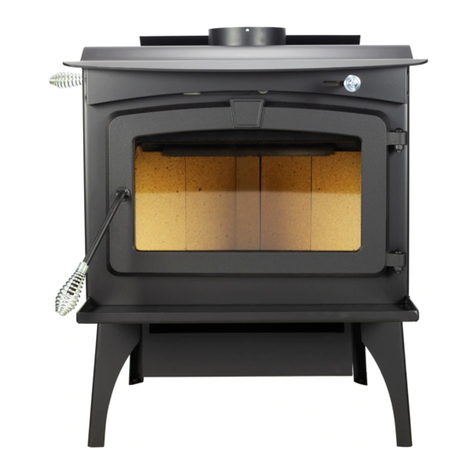
1
CAUTION
After reading these instructions, if you have any doubt
about your ability to complete your installation in a
professional like manner you should obtain the services
of an installer versed in all aspects as to the correct
and safe installation. Do not use temporary makeshift
compromises during installation.
BEFORE INSTALLATION OF YOUR APPLIANCE
1. Check with the building inspector’s office for
compliance with local codes; a permit may be required.
2. The room heater must be connected to 1) a chimney
complying with the requirements for Type HT chimneys
in the standard for Chimneys, Factory-Built, Residential
Type and Building Heating Appliance, UL 103, or in
Canada CAN/ULC-S629 Standard for 650 degree C
Factory Built Chimneys and applicable building codes or
2) a code-approved masonry chimney with a flue liner.
3. A 6” (152mm) diameter, 24 gauge Black Steel flue is
required for proper performance.
4. Always connect this unit to a chimney and NEVER
vent to another room or inside a building.
5. DO NOT connect this unit to any duct work to which
another appliance is connected such as a furnace.
6. DO NOT CONNECT THIS UNIT TO A CHIMNEY
FLUE SERVING ANOTHER APPLIANCE.
7. The connector pipe and chimney should be inspected
periodically and cleaned if necessary.
8. Remember the clearance distances when you place
furniture or other objects within the area. DO NOT store
wood, flammable liquids or other combustible materials
too close to the unit.
Refer to certification label on back of your unit for
required clearances.
9. Contact your local municipal or provincial fire
authority for information on how to handle a chimney
fire. Have a clearly understood plan to handle a chimney
fire. In the event of a Chimney fire, turn air control to
closed position and CALL THE FIRE DEPARTMENT.
10. DO NOT tamper with combustion air control beyond
normal adjustment.
11. DO NOT CONNECT TO ANY AIR DISTRIBUTION
DUCT OR SYSTEM.
12. When installing a solid fuel appliance, it is also
recommended to install Smoke and Carbon Monoxide
Detectors on every level of the house. During the initial
firing of the appliance, some smoke or odor may occur
due to paint curing. You may want to keep some
windows open for ventilation during the first few hours of
burning to prevent smoke detector activation. Test your
smoke and carbon monoxide detectors regularly.
CAUTION
DO NOT operate heater if glass window is broken.
OPERATION
WHY THE CORRECT FLUE SIZE IS IMPORTANT - 6”
Draft is the force which moves air from the appliance up
through the chimney. The amount of draft in your chimney
depends on the length of the chimney, local geography,
nearby obstructions, and other factors. Too much draft
may cause excessive temperatures in the appliance.
An uncontrolled burn or a glowing red part or chimney
connector indicates excessive draft. Inadequate draft may
cause back puffing into the room and “plugging” of the
chimney and/or cause the appliance to leak smoke into the
room through appliance and chimney connector joints.
Today’s solid fuel appliances are more efficient than in
the past. The units are designed to give you controlled
combustion, and maximum heat transfer, using less fuel to
do so.
The design of your new appliance is such that the exhaust
smoke is now at lower temperatures than in the past,
therefore requiring proper chimney size to give adequate
draft. If your chimney is too large, the heating appliance
will have a difficult time to raise the chimney flue
temperature to give adequate draft, therefore causing a
smoke back up, poor burn, or both.
Should you experience such a problem call in a local
chimney expert.
With the door closed, the rate of burning is regulated by
the amount of air allowed to enter the unit through the
air control. With experience you will be able to set the
control for heat and burning time desired.
Once the required chimney draft is obtained, operate only
with doors closed and open doors slowly when re-fueling.
(This will reduce or eliminate smoke from entering the
room).
Attempts to achieve higher output rates that exceed
heater design specifications can result in permanent
damage to the heater. The recommended wood load is
level with the top of the firebricks.
Overloading may prevent sufficient air entering the heater
to properly fuel the fire.
Operate this heater only with the door closed.
DO NOT BURN GARBAGE OR FLAMMABLE FLUIDS,
SUCH AS GASOLINE, NAPHTHA, OR ENGINE OIL
DO NOT USE CHEMICALS OR FLUIDS TO START
THE FIRE.
IMPORTANT: It is highly recommended that the wood
stove and chimney be installed by a qualified installer.
(A qualified installer is a person or entity who regularly
installs wood heating products and chimneys, in the
ordinary course of their regular business.)
This wood heater has a manufacturer-set minimum low
burn rate that must not be altered. It is against federal
regulations to alter this setting or otherwise operate this
wood heater in a manner inconsistent with operating
instructions in this manual.
HOT WHILE IN OPERATION. KEEP CHILDREN,
CLOTHING AND FURNITURE AWAY. CONTACT
MAY CAUSE SKIN BURNS.
ALWAYS PROVIDE A SOURCE OF FRESH AIR
INTO THE ROOM WHERE THE UNIT IS INSTALLED.
FAILURE TO DO SO MAY RESULT IN AIR STARVATION
OF OTHER FUEL BURNING APPLIANCES AND
THE POSSIBLE DEVELOPMENT OF HAZARDOUS
CONDITIONS.




























